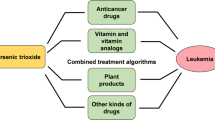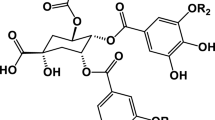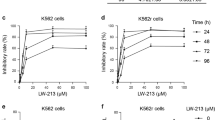Abstract
Arsenic trioxide (As2O3) is an effective therapy in acute promyelocytic leukemia (APL), but its use in other malignancies is limited by the higher concentrations required to induce apoptosis. We have reported that trolox, an analogue of α-tocopherol, increases As2O3-mediated apoptosis in a variety of APL, myeloma and breast cancer cell lines, while non-malignant cells may be protected. In the present study, we extended previous results to show that trolox increases As2O3-mediated apoptosis in the P388 lymphoma cell line in vitro, as evidenced by decrease of mitochondrial membrane potential and release of cytochrome c. We then sought to determine whether this combination can enhance antitumor effects while protecting normal cells in vivo. In BDF1 mice, trolox treatment decreased As2O3-induced hepatomegaly, markers of oxidative stress and hepatocellular damage. In P388 tumor-bearing mice, As2O3 treatment prolonged survival, and the addition of trolox provided a further significant increase in lifespan. In addition, the combination of As2O3 and trolox inhibited metastatic spread, and protected the tumor-bearing mice from As2O3 liver toxicity. Our results suggest, for the first time, that trolox might prevent some of the clinical manifestations of As2O3-related toxicity while increasing its pro-apoptotic capacity and clinical efficacy in hematological malignancies.
This is a preview of subscription content, access via your institution
Access options
Subscribe to this journal
Receive 12 print issues and online access
$259.00 per year
only $21.58 per issue
Buy this article
- Purchase on Springer Link
- Instant access to full article PDF
Prices may be subject to local taxes which are calculated during checkout






Similar content being viewed by others
References
Chen GQ, Shi XG, Tang W, Xiong SM, Zhu J, Cai X et al. Use of arsenic trioxide (As2O3) in the treatment of acute promyelocytic leukemia (APL): I. As2O3 exerts dose-dependent dual effects on APL cells. Blood 1997; 89: 3345–3353.
Shen ZX, Chen GQ, Ni JH, Li XS, Xiong SM, Qiu QY et al. Use of arsenic trioxide (As2O3) in the treatment of acute promyelocytic leukemia (APL): II. Clinical efficacy and pharmacokinetics in relapsed patients. Blood 1997; 89: 3354–3360.
Tallman MS . Acute promyelocytic leukemia as a paradigm for targeted therapy. Semin Hematol 2004; 41: 27–32.
Miller Jr WH, Schipper HM, Lee JS, Singer J, Waxman S . Mechanisms of action of arsenic trioxide. Cancer Res 2002; 62: 3893–3903.
Bazarbachi A, El-Sabban ME, Nasr R, Quignon F, Awaraji C, Kersual J et al. Arsenic trioxide and interferon-alpha synergize to induce cell cycle arrest and apoptosis in human T-cell lymphotropic virus type I-transformed cells. Blood 1999; 93: 278–283.
Rousselot P, Labaume S, Marolleau JP, Larghero J, Noguera MH, Brouet JC et al. Arsenic trioxide and melarsoprol induce apoptosis in plasma cell lines and in plasma cells from myeloma patients. Cancer Res 1999; 59: 1041–1048.
Zhu XH, Shen YL, Jing YK, Cai X, Jia PM, Huang Y et al. Apoptosis and growth inhibition in malignant lymphocytes after treatment with arsenic trioxide at clinically achievable concentrations. J Natl Cancer Inst 1999; 91: 772–778.
Rousselot P, Larghero J, Labaume S, Poupon J, Chopin M, Dosquet C et al. Arsenic trioxide is effective in the treatment of multiple myeloma in SCID mice. Eur J Haematol 2004; 72: 166–171.
Mathas S, Lietz A, Janz M, Hinz M, Jundt F, Scheidereit C et al. Inhibition of NF-kappaB essentially contributes to arsenic-induced apoptosis. Blood 2003; 102: 1028–1034.
Maeda H, Hori S, Nishitoh H, Ichijo H, Ogawa O, Kakehi Y et al. Tumor growth inhibition by arsenic trioxide (As2O3) in the orthotopic metastasis model of androgen-independent prostate cancer. Cancer Res 2001; 61: 5432–5440.
Zhang TC, Cao EH, Li JF, Ma W, Qin JF . Induction of apoptosis and inhibition of human gastric cancer MGC-803 cell growth by arsenic trioxide. Eur J Cancer 1999; 35: 1258–1263.
Akao Y, Nakagawa Y, Akiyama K . Arsenic trioxide induces apoptosis in neuroblastoma cell lines through the activation of caspase 3 in vitro. FEBS Lett 1999; 455: 59–62.
Seol JG, Park WH, Kim ES, Jung CW, Hyun JM, Lee YY et al. Potential role of caspase-3 and -9 in arsenic trioxide-mediated apoptosis in PCI-1 head and neck cancer cells. Int J Oncol 2001; 18: 249–255.
Uslu R, Sanli UA, Sezgin C, Karabulut B, Terzioglu E, Omay SB et al. Arsenic trioxide-mediated cytotoxicity and apoptosis in prostate and ovarian carcinoma cell lines. Clin Cancer Res 2000; 6: 4957–4964.
Kim KB, Bedikian AY, Camacho LH, Papadopoulos NE, McCullough C . A phase II trial of arsenic trioxide in patients with metastatic melanoma. Cancer 2005; 104: 1687–1692.
Parmar S, Rundhaugen LM, Boehlke L, Riley M, Nabhan C, Raji A et al. Phase II trial of arsenic trioxide in relapsed and refractory acute myeloid leukemia, secondary leukemia and/or newly diagnosed patients at least 65 years old. Leuk Res 2004; 28: 909–919.
Vuky J, Yu R, Schwartz L, Motzer RJ . Phase II trial of arsenic trioxide in patients with metastatic renal cell carcinoma. Invest New Drugs 2002; 20: 327–330.
Qian J, Qin S, He Z . Arsenic trioxide in the treatment of advanced primary liver and gallbladder cancer. Zhonghua Zhong Liu Za Zhi 2001; 23: 487–489.
Yi J, Yang J, He R, Gao F, Sang H, Tang X et al. Emodin enhances arsenic trioxide-induced apoptosis via generation of reactive oxygen species and inhibition of survival signaling. Cancer Res 2004; 64: 108–116.
Sturlan S, Baumgartner M, Roth E, Bachleitner-Hofmann T . Docosahexaenoic acid enhances arsenic trioxide-mediated apoptosis in arsenic trioxide-resistant HL-60 cells. Blood 2003; 101: 4990–4997.
Davison K, Cote S, Mader S, Miller WH . Glutathione depletion overcomes resistance to arsenic trioxide in arsenic-resistant cell lines. Leukemia 2003; 17: 931–940.
Gartenhaus RB, Prachand SN, Paniaqua M, Li Y, Gordon LI . Arsenic trioxide cytotoxicity in steroid and chemotherapy-resistant myeloma cell lines: enhancement of apoptosis by manipulation of cellular redox state. Clin Cancer Res 2002; 8: 566–572.
Skapek SX, Colvin OM, Griffith OW, Elion GB, Bigner DD, Friedman HS . Enhanced melphalan cytotoxicity following buthionine sulfoximine-mediated glutathione depletion in a human medulloblastoma xenograft in athymic mice. Cancer Res 1988; 48: 2764–2767.
Dai J, Weinberg RS, Waxman S, Jing Y . Malignant cells can be sensitized to undergo growth inhibition and apoptosis by arsenic trioxide through modulation of the glutathione redox system. Blood 1999; 93: 268–277.
Grad JM, Bahlis NJ, Reis I, Oshiro MM, Dalton WS, Boise LH . Ascorbic acid enhances arsenic trioxide-induced cytotoxicity in multiple myeloma cells. Blood 2001; 98: 805–813.
Karasavvas N, Carcamo JM, Stratis G, Golde DW . Vitamin C protects HL60 and U266 cells from arsenic toxicity. Blood 2005; 105: 4004–4012.
Diaz Z, Colombo M, Mann KK, Su H, Smith KN, Bohle DS et al. Trolox selectively enhances arsenic-mediated oxidative stress and apoptosis in APL and other malignant cell lines. Blood 2005; 105: 1237–1245.
Wu TW, Hashimoto N, Au JX, Wu J, Mickle DA, Carey D . Trolox protects rat hepatocytes against oxyradical damage and the ischemic rat liver from reperfusion injury. Hepatology 1991; 13: 575–580.
Imaeda A, Kaneko T, Aoki T, Kondo Y, Nagase H . DNA damage and the effect of antioxidants in streptozotocin-treated mice. Food Chem Toxicol 2002; 40: 979–987.
Berenbaum MC . Re: W. R. Greco et al., Application of a new approach for the quantitation of drug synergism to the combination of cis-diamminedichloroplatinum and 1-beta-D-arabinofuranosylcytosine. Cancer Res., 50: 5318-5327, 1990. Cancer Res 1992; 52: 4558–4560; reply: 4561–4555.
Pedlar RM, Ptashynski MD, Evans R, Klaverkamp JF . Toxicological effects of dietary arsenic exposure in lake whitefish (Coregonus clupeaformis). Aquat Toxicol 2002; 57: 167–189.
Santra A, Maiti A, Das S, Lahiri S, Charkaborty SK, Mazumder DN . Hepatic damage caused by chronic arsenic toxicity in experimental animals. J Toxicol Clin Toxicol 2000; 38: 395–405.
Oguro T, Hayashi M, Nakajo S, Numazawa S, Yoshida T . The expression of heme oxygenase-1 gene responded to oxidative stress produced by phorone, a glutathione depletor, in the rat liver; the relevance to activation of c-jun n-terminal kinase. J Pharmacol Exp Ther 1998; 287: 773–778.
Del Razo LM, Quintanilla-Vega B, Brambila-Colombres E, Calderon-Aranda ES, Manno M, Albores A . Stress proteins induced by arsenic. Toxicol Appl Pharmacol 2001; 177: 132–148.
Gupta R, Flora SJ . Protective effects of fruit extracts of Hippophae rhamnoides L. against arsenic toxicity in Swiss albino mice.. Hum Exp Toxicol 2006; 25: 285–295.
Strubelt O, Kremer J, Tilse A, Keogh J, Pentz R, Younes M . Comparative studies on the toxicity of mercury, cadmium, and copper toward the isolated perfused rat liver. J Toxicol Environ Health 1996; 47: 267–283.
Skrzydlewska E, Farbiszewski R . Trolox-derivative antioxidant protects against methanol-induced damage. Fundam Clin Pharmacol 1997; 11: 460–465.
Farbiszewski R, Witek A, Skrzydlewska E . N-acetylcysteine or trolox derivative mitigate the toxic effects of methanol on the antioxidant system of rat brain. Toxicology 2000; 156: 47–55.
Usuki F, Yasutake A, Umehara F, Tokunaga H, Matsumoto M, Eto K et al. In vivo protection of a water-soluble derivative of vitamin E, Trolox, against methylmercury-intoxication in the rat. Neurosci Lett 2001; 304: 199–203.
Karayianni V, Papageorgiou A, Mioglou E, Iakovidou Z, Mourelatos D, Fousteris M et al. 7-Keto hybrid steroidal esters of nitrogen mustard: cytogenetic and antineoplastic effects. Anticancer Drugs 2002; 13: 637–643.
Ishiki N, Onishi H, Machida Y . Antitumor activities of conjugates of mitomycin C with estradiol benzoate and estradiol via glutaric acid in suspension dosage form. Biol Pharm Bull 2002; 25: 1373–1377.
Liu QY, Tan BK . Relationship between anti-oxidant activities and doxorubicin-induced lipid peroxidation in P388 tumour cells and heart and liver in mice. Clin Exp Pharmacol Physiol 2003; 30: 185–188.
Hallberg CK, Trocme SD, Ansari NH . Acceleration of corneal wound healing in diabetic rats by the antioxidant trolox. Res Commun Mol Pathol Pharmacol 1996; 93: 3–12.
Betters JL, Criswell DS, Shanely RA, Van Gammeren D, Falk D, Deruisseau KC et al. Trolox attenuates mechanical ventilation-induced diaphragmatic dysfunction and proteolysis. Am J Respir Crit Care Med 2004; 170: 1179–1184.
Tan S, Liu YY, Nielsen VG, Skinner K, Kirk KA, Baldwin ST et al. Maternal infusion of antioxidants (Trolox and ascorbic acid) protects the fetal heart in rabbit fetal hypoxia. Pediatr Res 1996; 39: 499–503.
Flora SJ, Pant SC, Malhotra PR, Kannan GM . Biochemical and histopathological changes in arsenic-intoxicated rats coexposed to ethanol. Alcohol 1997; 14: 563–568.
Mallick P, Mallick JC, Guha B, Khuda-Bukhsh AR . Ameliorating effect of microdoses of a potentized homeopathic drug, Arsenicum Album, on arsenic-induced toxicity in mice. BMC Complement Altern Med 2003; 3: 7.
Bram S, Froussard P, Guichard M, Jasmin C, Augery Y, Sinoussi-Barre F et al. Vitamin C preferential toxicity for malignant melanoma cells. Nature 1980; 284: 629–631.
Van Driel BE, Lyon H, Hoogenraad DC, Anten S, Hansen U, Van Noorden CJ . Expression of CuZn- and Mn-superoxide dismutase in human colorectal neoplasms. Free Radic Biol Med 1997; 23: 435–444.
Sue K, Nakagawara A, Okuzono S, Fukushige T, Ikeda K . Combined effects of vitamin E (alpha-tocopherol) and cisplatin on the growth of murine neuroblastoma in vivo. Eur J Cancer Clin Oncol 1988; 24: 1751–1758.
Acknowledgements
We thank Dr Xiujie Li for assistance with histological analysis. We also thank Kathy Ann Forner, Veronique Michaud and Scott Hartigan for technical help with the animal model, and Dr Samuel Waxman for helpful discussions. This work was supported by grants from the Canadian Institutes of Health Research (CIHR) and the Samuel Waxman Cancer Research Foundation (to WH Miller Jr). WH Miller is a Chercheur National of the Fonds de la Recherche en Santé du Quebec (FRSQ). ZD is supported by student grant from the CIHR. KKM and AL are supported by fellowships from Montreal Centre for Experimental Therapeutics in Cancer (MCETC)/CIHR/FRSQ.
Author information
Authors and Affiliations
Corresponding author
Rights and permissions
About this article
Cite this article
Diaz, Z., Laurenzana, A., Mann, K. et al. Trolox enhances the anti-lymphoma effects of arsenic trioxide, while protecting against liver toxicity. Leukemia 21, 2117–2127 (2007). https://doi.org/10.1038/sj.leu.2404891
Received:
Accepted:
Published:
Issue Date:
DOI: https://doi.org/10.1038/sj.leu.2404891
Keywords
This article is cited by
-
Arsenic trioxide degrades NPM-ALK fusion protein and inhibits growth of ALK-positive anaplastic large cell lymphoma
Leukemia (2017)
-
Arsenite-loaded nanoparticles inhibit PARP-1 to overcome multidrug resistance in hepatocellular carcinoma cells
Scientific Reports (2016)
-
The evolving use of arsenic in pharmacotherapy of malignant disease
Annals of Hematology (2013)
-
Carbon tetrachloride-mediated lipid peroxidation induces early mitochondrial alterations in mouse liver
Laboratory Investigation (2012)
-
(+)α-Tocopheryl succinate inhibits the mitochondrial respiratory chain complex I and is as effective as arsenic trioxide or ATRA against acute promyelocytic leukemia in vivo
Leukemia (2012)



